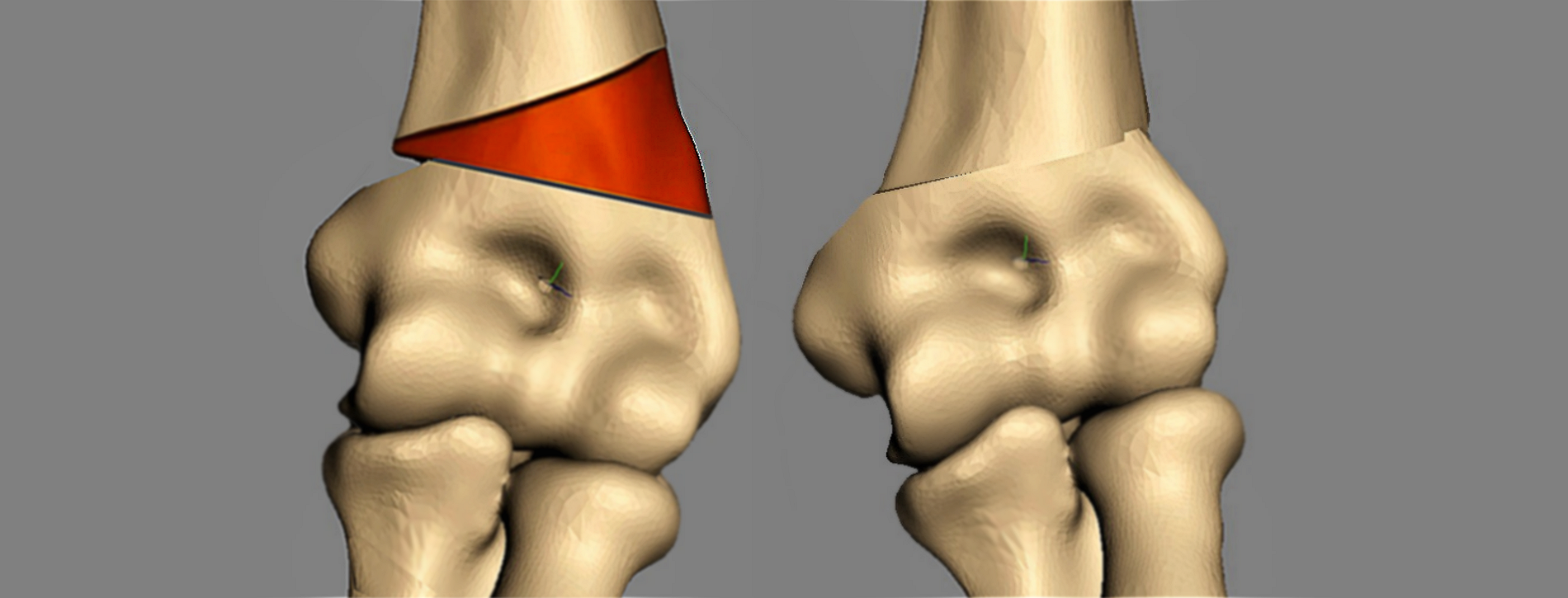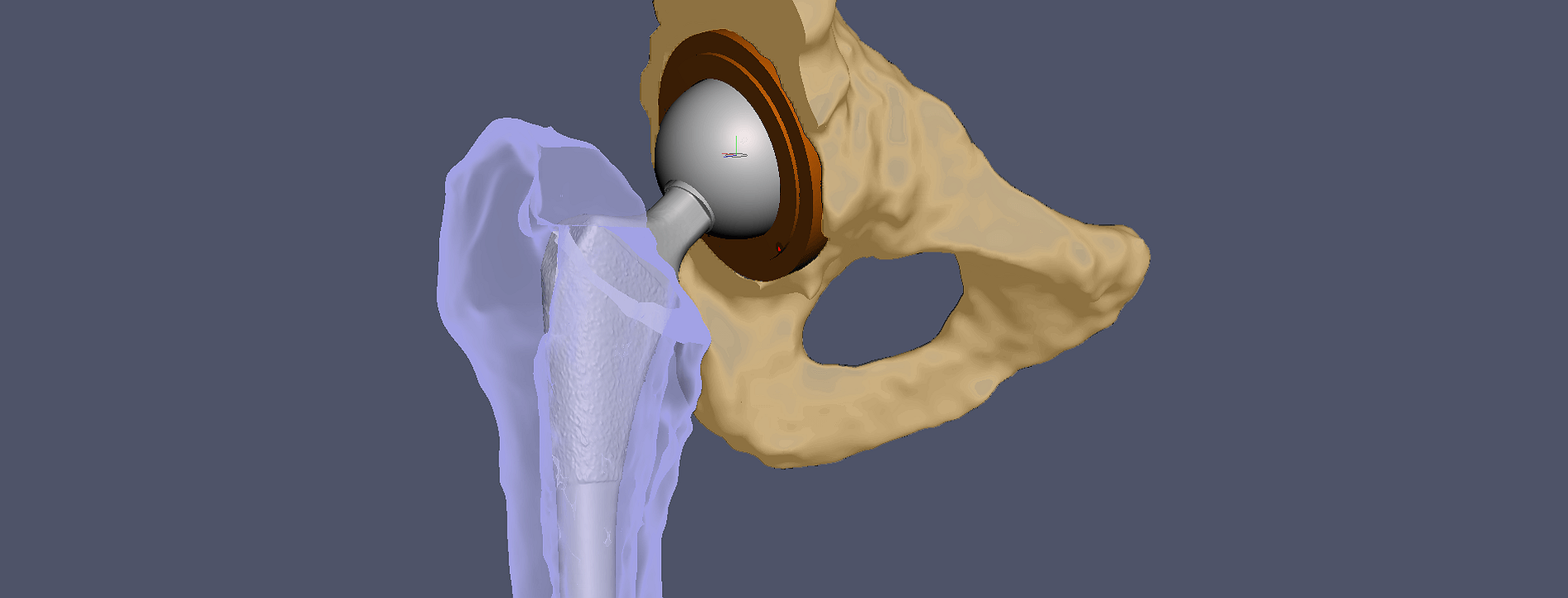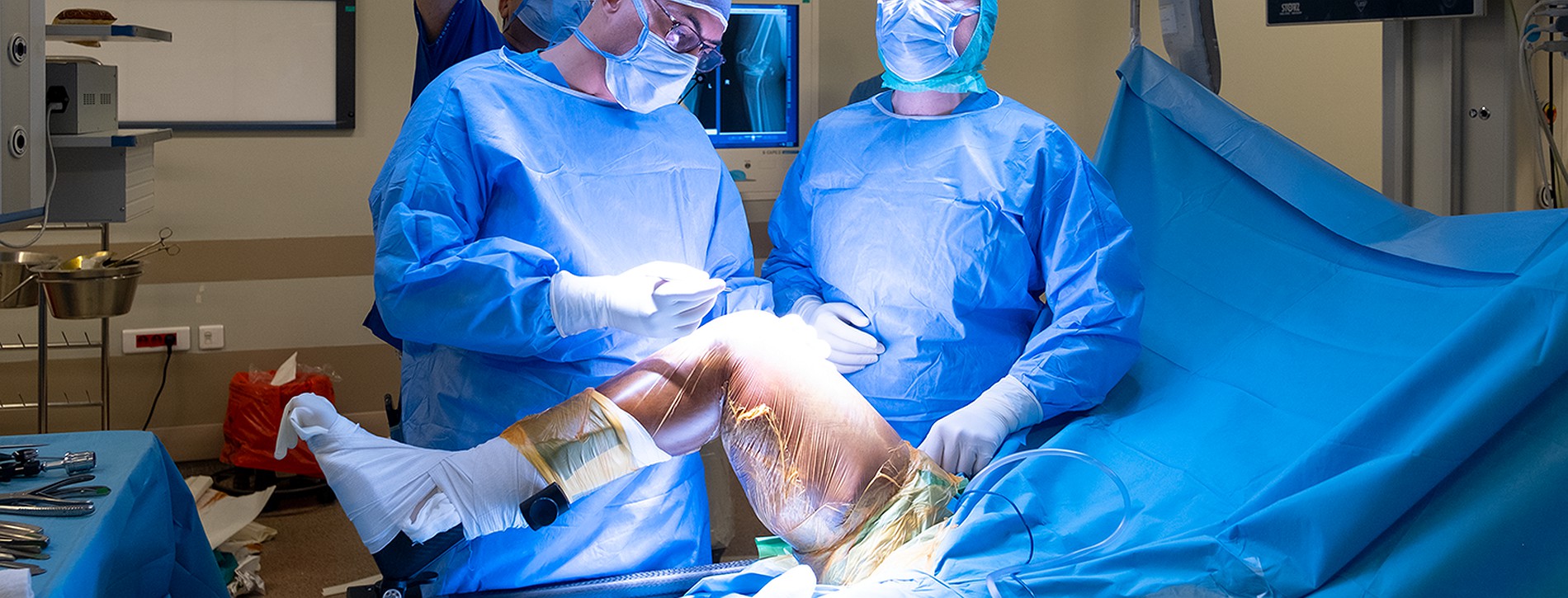3D Ortopedi ve Travmatoloji
3D Ortopedi ve Travmatoloji

Bilgisayar ortamında yapılan 3 boyutlu cerrahi planlama neticesinde tasarlanan hasta için özel cerrahi kılavuz sayesinde iskelet deformitelerini sağlam uzuvu örnek alarak mümkün olan en ideal şekilde düzeltiyoruz.
Detaylı Bilgi
3D bilgisayar ortamında planlanan ve MAKO robotu ile yerleştirilen protezler, mükemmel uyum ve daha uzun ömür sunar
Detaylı Bilgi
Hasta anatomisi için ideal protez yerleşiminin 3D bilgisayar ortamında planlanması ve MAKO robotunun yüksek hassasiyeti sayesinde mükemmel protez uyumu ve daha uzun ömür

Kalça osteonekroz hastalığında, 3D planlama ve 3D yazıcıyla üretilen hastaya özel cerrahi kılavuzlar yardımıyla yapılan kalça koruyucu cerrahi sayesinde hastalık erken evrede kontrol altına alınabilir.
Detaylı Bilgi
Birçok 3D cerrahi uygulamasıyla ülkemiz için ilklere imza atmış olan Dr. Gemalmaz aynı zamanda bu önemli teknolojinin ülkemizde yaygınlaşması için öncülük yapmaktadır.
Ortopedi ve Travmatoloji 3 boyutlu teknoloji devriminden fayda sağlayan tıp dalları arasında en başı çekmektedir
HakkımdaKişisel verileriniz, www.drcangemalmaz.com sitesi tarafından ve sitenin sahibi Doç. Dr. Halil Can Gemalmaz ve kendisinin sağlık hizmeti sunabilmesi için gerekli yardımcı personel de dahil olacak şekilde, 6698 sayılı Kişisel Verilerin Korunması Kanunu ve ilgili mevzuat kapsamında, aşağıda açıklanan çerçevede ve 3359 sayılı Sağlık Hizmetleri Temel Kanunu, 663 sayılı Sağlık Bakanlığı ve Bağlı Kuruluşlarının Teşkilat ve Görevleri Hakkında Kanun Hükmünde Kararname, Sağlık Bakanlığı düzenlemeleri ve diğer mevzuata uygun olarak işlenebilecektir.
Kişisel verileriniz www.drcangemalmaz.com sitesi ve Halil Can Gemalmaz tarafından sağlanmakta olan tıbbi teşhis, tedavi ve bakım hizmetlerinin yürütülmesi, sağlık hizmetlerinin planlanması amaçlarıyla; sözlü, yazılı, görsel ya da elektronik ortamda, çağrı merkezi, internet sitesi, sözlü, yazılı ve benzeri kanallar aracılığıyla elde edilmektedir. Sağlık verileriniz ve kişisel verileriniz, Doç. Dr. Halil Can Gemalmaz tarafından aşağıda yer alanlar dahil ve bunlarla sınırlı olmamak kaydıyla tıbbi amaçlar ile bağlantılı şekilde işlenebilmektedir:
● Kimlik bilgileriniz: Adınız, Soyadınız, T.C. Kimlik numaranız, pasaport numaranız veya geçici TC Kimlik numaranız, doğum yeri ve tarihiniz, medeni haliniz, cinsiyetiniz, sigorta veya hasta protokol numaranız ve sizi tanımlayabileceğimiz diğer kimlik verileriniz.
● İletişim Bilgileriniz: Adresiniz, telefon numaranız, elektronik posta adresiniz, diğer iletişim verileriniz ve elektronik posta, mektup veya diğer vasıtalar aracılığı ile tarafımızla iletişime geçtiğinizde elde edilen kişisel verileriniz.
● Sağlık hizmetlerinin finansmanı ve planlaması amacıyla özel sağlık sigortasına ilişkin verileriniz ve Sosyal Güvenlik Kurumu verileriniz.
● Sağlık Bilgileriniz: Laboratuvar sonuçlarınız, test sonuçlarınız, muayene verileriniz, randevu bilgileriniz, reçete bilgileriniz dahil ancak bunlarla sınırlı olmaksızın tıbbi teşhis, tedavi ve bakım hizmetlerinin yürütülmesi sırasında veya bunların bir sonucu olarak elde edilen her türlü sağlıkla ilgili kişisel verileriniz.
● www.drcangemalmaz.com sitesine ve site içeriğinde bulunan sayfalar ve formlar üzerinden gönderdiğiniz veya girdiğiniz sağlık verileriniz ve diğer kişisel verileriniz.
● WhatsApp uygulaması (veya benzeri yazışma uygulamaları) ya da eposta yoluyla ulaşarak yapılacak görüşme sonucunda elde edilen kişisel verileriniz.
● Sosyal medya üzerinden yapılan tanıtım ve reklam üzerinden “bize ulaşın” veya “bilgi alın” gibi paneller aracılığı ile yapılan başvurular sonucunda elde edilen kişisel verileriniz.
www.drcangemalmaz.com sitesi tarafından elde edilen her türlü kişisel veriniz (Özel nitelikli kişisel veriler de dahil fakat bunlarla sınırlı olmamak kaydıyla) aşağıdaki amaçlar ile işlenebilecektir:
● Kimliğinizi teyit etme,
● Tıbbi teşhis, tedavi ve bakım hizmetlerinin yürütülmesi, sağlık hizmetleri planlanması.
● İlgili mevzuat uyarınca Sağlık Bakanlığı ve diğer kamu kurum ve kuruluşları ile talep edilen bilgilerin paylaşılması.
● Randevu almanız halinde randevu hakkında sizi haberdar edebilme.
● Sağlık hizmetlerini geliştirme amacıyla analiz yapma.
● Araştırma yapılması.
● Yasal ve düzenleyici gereksinimlerin yerine getirilmesi.
● Sağlık hizmetlerinin finansmanı kapsamında özel sigorta şirketler ile talep edilen bilgileri paylaşma.
● Hizmetlerimiz karşılığında faturalandırma yapılması.
İlgili mevzuat uyarınca www.drcangemalmaz.com sitesi üzerinden elde edilen ve işlenen kişisel verileriniz, büyük bir hassasiyetle ve mevzuat hükümlerine tam riayet ederek fiziki ve elektronik ortamlarda her türlü idari ve teknik tedbirler alınarak korunmaktadır.
Kişisel verileriniz, Kanun ve diğer mevzuat kapsamında ve yukarıda yer verilen amaçlarla Doç. Dr. Halil Can Gemalmaz ve hizmet sunarken birlikte çalıştığı kişiler, Özel sigorta şirketleri, Sağlık bakanlığı ve bağlı alt birimleri, Sosyal Güvenlik Kurumu, Emniyet Genel Müdürlüğü ve diğer kolluk kuvvetleri, Nüfus Genel Müdürlüğü, Türkiye Eczacılar Birliği, Mahkemeler ve her türlü yargı makamı, merkezi ve diğer üçüncü kişiler, yetki vermiş olduğunuz temsilcileriniz, avukatlar, vergi ve finans danışmanları ve denetçiler de dahil olmak üzere danışmanlık aldığımız üçüncü kişiler, düzenleyici ve denetleyici kurumlar, resmi merciler dahil sağlık hizmetlerini yukarıda belirtilen amaçlarla geliştirmek veya yürütmek üzere işbirliği yaptığımız iş ortaklarımız ve diğer üçüncü kişiler ile paylaşılabilecektir.
Kişisel verileriniz, her türlü sözlü, yazılı, görsel ya da elektronik ortamda, yukarıda yer verilen amaçlar ve www.drcangemalmaz.com sitesi ve Doç. Dr. Halil Can Gemalmaz’ın faaliyet konusuna dahil her türlü işin yasal çerçevede yürütülebilmesi ve bu kapsamda Doç. Dr. Halil Can Gemalmaz’ın sözleşme ve kanuni yükümlülüklerini tam olarak yerine getirebilmesi için toplanmakta ve işlenmektedir. Kişisel verilerinizin toplanmasının hukuki dayanağı;
● 6698 sayılı Kişisel Verilerin Korunması Kanunu,
● 3359 sayılı Sağlık Hizmetleri Temel Kanunu,
● 663 sayılı Sağlık Bakanlığı ve Bağlı Kuruluşlarının Teşkilat ve Görevleri Hakkında Kanun Hükmünde Kararname,
● Kişisel Sağlık Verilerinin İşlenmesi ve Mahremiyetinin Korunması Yönetmeliği,
● Sağlık Bakanlığı düzenlemeleri ve diğer mevzuat hükümleridir.
Ayrıca, Kanun’un 6. maddesi 3. fıkrasında da belirtildiği üzere sağlıkla ilgili kişisel veriler tıbbı teşhis, tedavi ve bakım hizmetlerinin yürütülmesi, sağlık hizmetleri ile finansmanının planlanması ve yönetimi amacıyla, sır olarak saklama yükümlülüğü şart koşulan kişiler ve kanunlarla yetkili kılınmış kurum ve kuruluşlar tarafından ilgilinin açık rızası aranmaksızın işlenebilir.
Kanun ve ilgili mevzuatlar uyarınca;
● Kişisel veri işlenip işlenmediğini öğrenme,
● Kişisel veriler işlenmişse buna ilişkin bilgi talep etme,
● Kişisel sağlık verilerine erişim ve bu verileri isteme,
● Kişisel verilerin işlenme amacını ve bunların amacına uygun kullanılıp kullanılmadığını öğrenme,
● Yurt içinde veya yurt dışında kişisel verilerin aktarıldığı üçüncü kişileri bilme,
● Kişisel verilerin eksik veya yanlış işlenmiş olması halinde bunların düzeltilmesini isteme,
● Kişisel verilerin silinmesini veya yok edilmesini isteme,
● Kişisel verilerin eksik veya yanlış işlenmiş olması halinde bunların düzeltilmesine ve/veya kişisel verilerin silinmesine veya yok edilmesine ilişkin işlemlerin kişisel verilerin aktarıldığı üçüncü kişilere bildirilmesini isteme,
● İşlenen verilerin münhasıran otomatik sistemler vasıtasıyla analiz edilmesi suretiyle kişinin kendisi aleyhine bir sonucun ortaya çıkmasına itiraz etme hakkına haizsiniz.
Bu haklarınızı kullanmanız halinde ilgili bilgi tarafınıza, açık ve anlaşılabilir bir şekilde yazılı olarak ya da elektronik ortamda, tarafınızca sağlanan iletişim bilgileri yoluyla, bildirilir.
www.drcangemalmaz.com sitesi ve Doç. Dr. Halil Can Gemalmaz, kişisel verilerinizi bilinen bilgi güvenliği standartları ve prosedürlerine uygun olarak ve alınması gereken tüm teknik tedbirler gözetilerek korumaktadır. Söz konusu güvenlik tedbirleri, teknolojik imkanlar da göz önünde bulundurularak muhtemel riske uygun bir düzeyde sağlanmaktadır.
Kişisel verileriniz teknik ve idari imkanlar dahilinde titizlikle korunmakta ve gerekli güvenlik tedbirleri, teknolojik imkanlar da göz önünde bulundurularak olası risklere uygun bir düzeyde sağlanmaktadır. Kanun kapsamındaki taleplerinizi;
● (i) Teşvikiye Mh, Hakkı Yeten Cd. 17/7 Şişli, İstanbul, Türkiye adresine kargo ile ıslak imzanızı taşıyan bir dilekçe ile Zarfına “Kişisel Verilerin Korunması Kanunu Kapsamında Bilgi Talebi” yazarak gönderebilirsiniz,
● (ii) Noter kanalıyla gönderebilir,
● (iii) iletisim@drcangemalmaz.com eposta adresine “Kişisel Verilerin Korunması Kanunu Uyarınca Başvuru” başlığı altında elektronik ya da mobil imzalı olarak, kayıtlı elektronik posta adresi veya sistemimizde kayıtlı elektronik e-posta adresiniz aracılığıyla iletebilirsiniz.


